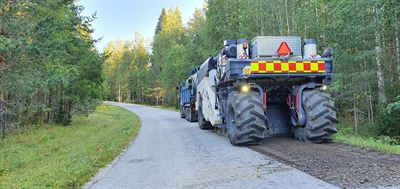

The construction company YIT is testing a new method of road maintenance which uses wood fibre to strengthen gravel roads. ‘A dilapidated road is treated with lignosulphonate, which acts as a binding agent, causing the crushed stones on the surface to bond together,’ says Site Manager Olli-Pekka Kurki from YIT.
The method is used for the upkeep and maintenance of gravel roads, and is not envisaged to replace bitumen, which is a raw material of the asphalt used to pave roads.
The lignosulphonate-based binding agent improves the surface of gravel roads and reduces frost damage on the road surface. Roads treated with this agent can be maintained in the normal way by levelling or adding crushed stone.
Lignosulphonates, or sulphonated lignin, are made of lignin, which is the substance that binds wood fibres together and makes up 20–30% of wood.
Lignin is the most common biopolymer in the world after cellulose. Among other things, it can be used to manufacture xylitol and vanillin. Lignosulphonate is also used as a binding agent in adhesives and resins, and as plasticizer in concrete.
After being separated from black liquor, a sidestream of coniferous pulp production, lignin is called lignosulphonate.
In studies spanning more than 15 years, stabilization with lignosulphonate has been found to increase road life by up to seven years. Compared to other stabilization agents, the carbon dioxide emissions from lignosulphonate are much smaller and its production actually binds carbon dioxide, since it is the natural binding agent for wood fibres.
The new binding agent is being piloted at several spots over a total length of four kilometres along the Pyylintie road on the boundary of the Heinävesi and Enonkoski municipalities in eastern Finland.
‘We’re running this pilot together with the regional Centre for Economic Development, Transport and the Environment, and further work will depend on the success of the pilot,’ says Kurki.
In Pyylintie, lignosulphonate was also tested for binding dust over a total length of 15 kilometres. ‘Lignosulphonate is a good alternative to using chlorides for dust binding, and can replace them either fully or in part,’ Kurki adds.
Kuvateksti: On the boundary between Heinävesi and Enonkoski municipalities, south-eastern Finland, the substance that binds wood fibres together was tested for improving gravel roads. Photo: YIT
Additional information:
